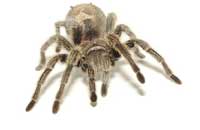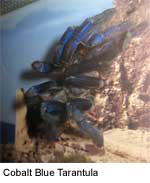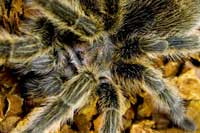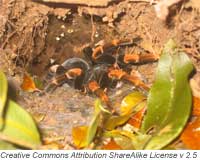|

 Tarantulas are long-legged, long-living spiders, whose entire body is covered with short glittery hairs called setae. Distribution: Tarantulas inhabit tropical to temperate regions in South America and Central America, Mexico, and the southwestern United States, Asia, Southern Europe, Africa and Australia. In South Africa they are sometimes referred to as Baboon Spiders. Tarantulas are long-legged, long-living spiders, whose entire body is covered with short glittery hairs called setae. Distribution: Tarantulas inhabit tropical to temperate regions in South America and Central America, Mexico, and the southwestern United States, Asia, Southern Europe, Africa and Australia. In South Africa they are sometimes referred to as Baboon Spiders.
 Body: The body of the tarantula pictured to the left is approximately 2.5 inches (6.2 cm) long. Despite their often scary appearance and reputation, none of the true tarantulas are included in the list of deadly spiders (spiders having a strong toxin, dangerous to humans), and this particular kind of tarantula is regarded as especially docile. Body: The body of the tarantula pictured to the left is approximately 2.5 inches (6.2 cm) long. Despite their often scary appearance and reputation, none of the true tarantulas are included in the list of deadly spiders (spiders having a strong toxin, dangerous to humans), and this particular kind of tarantula is regarded as especially docile.
Size: Tarantulas are not all large. Depending on the species, their body length may vary from 1-4 inches (2.5 - 10 cm), with 3 to 12 inch (8-30 cm) leg spans (their size when including their legs). Size is measured by measuring from the tip of the back leg to the tip of the front leg on the same side.
Largest: The largest species of tarantulas can weigh over 3 ounces (90 grams). The Goliath birdeater (Theraphosa blondi) from Venezuela and Brazil is generally regarded to be the largest species, however some breeders and hobbyists believe otherwise. The Pinkfoot goliath tarantula (Theraphosa apophysis) was described 187 years after the goliath birdeater; therefore it is not as well-known. However legspans of up to 13 inches have been reported. In general the males of most species are slimmer and longer legged than the females.
 Color: The majority of tarantulas are brown or black, however some species have more extensive coloration patterns, ranging from cobalt blue (cobalt blue tarantula, Haplopelma lividum), black with white stripes (pink zebra beauty or Eupalaestrus campestratus and Brazilian giant white knee tarantula or Acanthoscurria geniculata) to metallic blue legs with vibrant orange abdomen (greenbottle blue tarantula, Chromatopelma cyaneopubescens). Their natural habitats include savanna, grasslands such as the pampas, rainforests, deserts, scrubland, mountains and cloud forests. They are generally divided into terrestrial types (that frequently make burrows) and arboreal types. Color: The majority of tarantulas are brown or black, however some species have more extensive coloration patterns, ranging from cobalt blue (cobalt blue tarantula, Haplopelma lividum), black with white stripes (pink zebra beauty or Eupalaestrus campestratus and Brazilian giant white knee tarantula or Acanthoscurria geniculata) to metallic blue legs with vibrant orange abdomen (greenbottle blue tarantula, Chromatopelma cyaneopubescens). Their natural habitats include savanna, grasslands such as the pampas, rainforests, deserts, scrubland, mountains and cloud forests. They are generally divided into terrestrial types (that frequently make burrows) and arboreal types.
Sexual dimorphism: Many tarantula species exhibit pronounced sexual dimorphism. Males tend to be smaller (especially the abdomen) and may be quite colourful, as in the very large Bolivian and Peruvian species Pamphobeteus antinous, in which the female is dark brown and the male shiny iridescent purple. Males also tend to have shorter lifespans. For these reasons, most tarantulas kept as pets are female.
 Hair: Besides the normal hairs covering the body of tarantulas, some also have a dense covering of irritating hairs (about 10,000 per mm² ), called urticating hairs, on the opisthosoma, that they sometimes use as a protection against enemies. These hairs are only present on some New World species of the subfamilies of Ischnocolinae, Aviculariinae, Grammostolinae and Theraphosinae ) and are absent on specimens of the Old World. They help in phylogenetic studies of Theraphosinae . Hair: Besides the normal hairs covering the body of tarantulas, some also have a dense covering of irritating hairs (about 10,000 per mm² ), called urticating hairs, on the opisthosoma, that they sometimes use as a protection against enemies. These hairs are only present on some New World species of the subfamilies of Ischnocolinae, Aviculariinae, Grammostolinae and Theraphosinae ) and are absent on specimens of the Old World. They help in phylogenetic studies of Theraphosinae .
These fine hairs are barbed, and designed to urticate, but do not contain venom. Some species can 'kick off' these hairs: the hairs are launched into the air at a target. Tarantulas also use these hairs for other means. They mark their territories with these hairs, using them to mark territory or to line the web or nest (the latter such practice may discourage flies from feeding on the spiderlings).
To predators and other kinds of enemies, these hairs can range from being lethal to simply being a deterrent. With humans, they can cause irritation to eyes, nose, and skin, and more dangerously, the lungs and airways, if inhaled. The symptoms range from species to species, from person to person, from a burning itch to a minor rash. Tarantula hair has been used as the main ingredient in the novelty item "itching powder." Some tarantula enthusiasts have had to give up their spiders because of allergic reactions to these hairs (skin rashes, problems with breathing, and swelling of the affected area).
Prey: Tarantulas are nocturnal predators, killing their prey by injecting venom through their fangs. The hungry tarantula typically waits partially hidden at the entrance to its retreat to ambush passing prey. It has sensitive hairs that enable it to detect the size and location of potential victims from the vibrations caused by their movements. Some species also use their silk fiber to detect motion (when a prey trigger a line). Like many other spiders, it cannot see much more than light, darkness, and movement (see spiders for more about their eyesight), and uses its sense of touch to perceive the world around it. That being said, they are anything but sloppy or imprecise about the way they capture their prey. They generally seem to choose prey on the basis of how dangerous they are perceived to be, the general size of the potential prey animal, etc. Some tarantulas succeed in occasionally capturing small birds, small mammals such as mice, and even small fish, but their ordinary prey consists of insects such as crickets (for ground dwellers) and moths (for arboreal species).
 Nests: Tarantulas live in a variety of nests. Burrowing tarantulas live underground, in burrows. These burrows are either dug by the spider itself, or else they reuse burrows abandoned by rodents or other small creatures, or they find ready-made crevices. The tunnels are lined with silk and a webbed rim is formed at the entrance so as to conceal it. Other tarantulas make their homes under rocks or tree trunks or under the loose bark of trees. Still others build silken nests on trees, cliff faces, the walls of buildings or in plants such as bananas and pineapples. Tarantulas are well suited for climbing. Even heavy-bodied terrestrial tarantulas such as Grammostola rosea can climb vertical sheets of glass, but climbing very high presents a serious danger to them since any substantial fall can rupture their abdomens. The arboreal species are lighter of body and more able to withstand substantial falls. Nests: Tarantulas live in a variety of nests. Burrowing tarantulas live underground, in burrows. These burrows are either dug by the spider itself, or else they reuse burrows abandoned by rodents or other small creatures, or they find ready-made crevices. The tunnels are lined with silk and a webbed rim is formed at the entrance so as to conceal it. Other tarantulas make their homes under rocks or tree trunks or under the loose bark of trees. Still others build silken nests on trees, cliff faces, the walls of buildings or in plants such as bananas and pineapples. Tarantulas are well suited for climbing. Even heavy-bodied terrestrial tarantulas such as Grammostola rosea can climb vertical sheets of glass, but climbing very high presents a serious danger to them since any substantial fall can rupture their abdomens. The arboreal species are lighter of body and more able to withstand substantial falls.
Molting: Like other spiders, tarantulas have to shed their exoskeleton periodically in order to grow, a process called molting. Young tarantulas may do this several times a year, while full grown specimens will only molt once every year or so, or sooner in order to replace lost limbs or lost urticating hairs.
Maturity: Tarantulas may live for many years--most species taking 2 to 5 years to reach adulthood, but some species may take up to 10 years to reach full maturity. Upon reaching adulthood, males have typically have but a 1 to 1.5 year period left to live and will immediately go in search of a female with which to mate. It is rare that upon reaching adulthood the male tarantula will molt again.
Regeneration: Since females will continue to molt after reaching maturity, they are able to regenerate lost limbs and increase their lifespan. Female specimens have been known to reach 30 years of age and even 40 years, and have survived on water alone for up to 2.5 years. If well cared for, females can expect to live 20-30 years and males 10-12 years, depending on the species.
Social behavior: Tarantulas usually live in solitude and will attack others of their own kind. There are however exceptions, such as the pinktoe tarantula (Avicularia avicularia), which can be kept communally. Keep in mind ALL tarantulas are cannibalistic; it is always possible one tarantula will eat another. Avicularia Spp. are simply more tolerant of each other. If the vivarium is big enough, has enough hiding spots, and the specimens are about the same size and well fed, there should be little or no cannibalism. Keeping tarantulas communally is not recommended and should not be attempted except by experienced keepers.
Tarantulas as pets: Tarantulas can be kept as pets and are considered good "apartment pets" by many, being quiet animals, requiring surprisingly little maintenance or cleaning, since unlike snakes and lizards they have no detectable odor. Because of their docile personality and beauty, the most common species kept as pets are the Chilean rose tarantula (Grammostola rosea, for their price) and the mexican redknee tarantula (Brachypelma smithi, for their beauty). These two species are also some of the easier to care for and are usually easy to handle. Tarantulas also make quite inexpensive pets. Most species can be purchased as juveniles for $20-$50. Adults can be quite expensive as they approach breeding age and adults of many species can easily reach the several hundred dollar range. Housing for most species can cost another $40 or so. Unfortunately, few pet shops have the required knowledge for proper tarantula care and can often subject tarantulas to poor living conditions due to this ignorance. Various species can require significantly different care and a care sheet for the specific species you are caring for should be used.
Terrarium: A terrarium with an inch or two of damp ground coconut fiber, or a mixture of soil and sphagnum moss (but not with cedar shavings as they are toxic to many spiders) on bottom provides an ideal habitat. (Burrowing tarantulas will require a much deeper layer.) Ambient temperature and humidity vary by species, with most thriving between 75 degrees and 80ºF (24 to 30ºC) and between 40% and 80% humidity.
Feeding: Tarantulas can be fed a variety of living animals (insects, small mice or Pinky Mice, small fish in the water bowl, and reptiles are some of the foods tarantulas eat). Tarantulas should NOT be fed vertebrates on a regular basis as the calcium in the bones will cause complications during molting and may kill the tarantula. A tropical roach colony is a good way to maintain a food supply for a number of tarantulas. The discoid cockroach and death's head cockroach in particular are very easy to care for and will not infest your home if they escape. The death's head cockroaches can be kept in an aquarium with no lid since they cannot climb glass and don't fly. Maintaining a colony of death's head cockroaches only requires keeping them in the dark, feeding them a handful of dog food every couple of weeks and misting them with water every day or two. Hybrid death's head cockroaches are just as good and half the price.
Other tarantulas that may make interesting pets are the Brazilian (or "giant") whiteknee, Chaco golden knee, and Brazilian salmon pink birdeater. These are three of the larger species, each growing over 8 inches with the Brazilian birdeater sometimes reaching 10 inches and considered by many to be the largest species that is docile enough to handle. The Chaco and the Brazilian whiteknee tarantula are also quite pretty. Chaco golden knee tarantulas are generally quite docile. Giant white knees and the salmon birdeaters tend to be nervous and sometimes aggressive. The foregoing are terrestrial tarantulas, i.e., they generally live in burrows or natural shelters near the ground. Arboreal tarantulas require different housing since, when adult, they make webbed shelters well above ground. A few of the Avicularia spiders are well suited for beginners. Those include Avicularia avicularia and Avicularia metallica, which are generally quite calm and rarely bite. (Any spider will bite if it is being hurt or put in fear for its life.) The arboreal spiders can have large legspans, but their bodies are much less massive than the typical terrestrial tarantulas.

Search for mates: The habit of male spiders wandering in search of mates makes them especially visible. In late summer and early autumn (September and October in the northern hemisphere), the males will leave their hiding places and walk about, hoping to encounter the hiding place of a female with which to mate. They are willing to cross roads and trails in this quest, and that is when they are most likely to be observed.
Drawing the female out: When the mature male encounters the burrow of a female, he will draw the female out and signal his intentions to mate by vibrating his body and tapping his front legs. If the female is receptive to mating, she will also vibrate and tap her legs. After mating, the male must get away quickly, or it is possible that he will be eaten. A female tarantula who is unreceptive to mating may also eat the male if he attempts to mate. This result, however, is less common among tarantulas than other spiders. Certain species of tarantulas have been known to mate multiple times over the course of several weeks.
Mechanics: As with other spiders, the mechanics of intercourse are quite different from those of mammals. Once they reach maturity and become motivated to mate, male spiders will weave a web mat on a flat surface. They then rub their abdomens on the surface of this mat and so doing causes them to release a quantity of semen onto the mat. They then insert their pedipalps (the short leg-like appendages between their chelicerae and their front legs) into the pool of semen. The pedipalps absorb the semen and maintain it in viable condition for sufficient time for the male spider to find a suitable female spider with whom to mate. When a male spider detects the presence of a female he must first exchange signals with her to establish the fact that they are members of the same species and to lull the female into a receptive state. Then the male approaches the female and inserts his pedipalps into the appropriate opening in the lower surface of her abdomen. After the semen has been transferred to the receptive female's body, the male will generally be well advised to leave the scene before the female recovers her appetite.
Eggs: The females deposit 50 to 2000 eggs, depending on the species, in a silken egg sac and guard it for 6 to 7 weeks. The young spiderlings remain in the nest for some time after hatching and then disperse by crawling in all directions.

The family Theraphosidae is divided up into 12 sub-families, as follows. Sub-family Spelopelminae was recently merged with Theraphosinae, and its single genus merged into the genus Hemirrhagus.
Subfamily Acanthopelminae
Main article: Acanthopelminae
Acanthopelminae, first described by Frederick Octavius Pickard-Cambridge in 1897, is a sub-family of small, terrestrial New World tarantulas. This sub-family has only one genus, Acanthopelma, and two species, A. beccarri and A. rufescens, found in Guyana and Central America.
Genus:
* Acanthopelma, F. O. P.-Cambridge, 1897
Subfamily Aviculariinae
Aviculariinae are a sub-family of tropical, tree-dwelling New World tarantulas. They range from the Caribbean to South America, and are commonly known as "pinktoe" tarantulas. The genera Avicularia, Ephebopus and Pachistopelma possess urticating hairs, but cannot "flick" them into the air; instead the hairs are pressed into an enemy upon contact.
Genera:
* Avicularia Lamarck, 1818
* Ephebopus Simon, 1892
* Iridopelma Pocock, 1901
* Pachistopelma Pocock, 1901
Subfamily Eumenophorinae
Eumenophorinae are a sub-family of old-world tarantulas, mostly from Africa and surrounding regions.
Genera:
* Anoploscelus Pocock, 1897
* Batesiella Pocock, 1903
* Citharischius Pocock, 1900
* Encyocrates Simon, 1892
* Eumenophorus Pocock, 1897
* Hysterocrates Simon, 1892
* Loxomphalia Simon, 1889
* Loxoptygus Simon, 1903
* Mascaraneus Gallon, 2005
* Monocentropus Pocock, 1897
* Myostola Simon, 1903
* Phoneyusa Karsch, 1884
In addition, some authors place genus Proshapalopus (a genus found in Brazil, and not in Africa) in this sub-family.
[edit]
Subfamily Harpactirinae
Main article: Harpactirinae
Sub-family Harpactirinae are a group of old-world tarantulas from Africa, though smaller than Eumenophorinae. They are known as baboon spiders for their hairy legs and the thick black scorpulae at the end of their feet, which are said to resemble baboons.
Genera:
* Augacephalus Gallon, 2002
* Ceratogyrus Pocock, 1897
* Eucratoscelus Pocock, 1898
* Harpactira Ausserer, 1871
* Harpactirella Purcell, 1902
* Idiothele Hewitt, 1919
* Pterinochilus Pocock, 1897
* Trichognathella Gallon, 2004
Subfamily Ischnocolinae
Main article: Ischnocolinae
Sub-family Ischnocolinae contains spiders from around the world.
Genera:
* Catumiri Guadanucci, 2004
* Chaetopelma Ausserer, 1871
* Cratorrhagus Simon, 1891
* Hemiercus Simon, 1903
* Heterothele Karsch, 1879
* Holothele Karsch, 1879
* Ischnocolus Ausserer, 1871
* Nesiergus Simon, 1903
* Oligoxystre Vellard, 1924
* Plesiophrictus Pocock, 1899
* Pseudoligoxystre Vol, 2001
* Sickius Soares & Camargo, 1948
Subfamily Ornithoctoninae
Main article: Ornithoctoninae
The earth tigers of sub-family Ornithoctoninae are a group of old-world tarantulas which are found primarly in Southeast Asia, southern China, and Borneo. This group includes the infamous Chinese bird spider, and species in this sub-family are known for being ill-tempered.
Genera:
* Citharognathus Pocock, 1895
* Cyriopagopus Simon, 1887
* Haplopelma Simon, 1892
* Lampropelma Simon, 1892
* Ornithoctonus Pocock, 1892
* Phormingochilus Pocock, 1895
Subfamily Poecilotheriinae
Main article: Poecilotheriinae
Sub-family Poecilotheriinae are tree spiders from India and Sri Lanka, some of which are considered Template:Endangered species. This sub-family contains only a single genus.
Genus:
Poecilotheria Simon, 1885
Subfamily Selenocosmiinae
Main article: Selenocosmiinae
Sub family Selenocosmiinae. This sub-family consists mainly of tarantulas from East Asia and Australia. Like the East Asian tarantulas in Ornithoctoninae, these are known for their strong venom and defensive disposition. The genera Psalmopoeus and Tapinauchenius do not have urticating hairs, unusual among New World species.
Genera:
* Chilobrachys Karsch, 1891
* Coremiocnemis Simon, 1892
* Haplocosmia Schmidt & von Wirth, 1996
* Lyrognathus Pocock, 1895
* Orphnaecus Simon, 1892
* Phlogiellus Pocock, 1897
* Psalmopoeus Pocock, 1895
* Selenobrachys Schmidt, 1999
* Selenocosmia Ausserer, 1871
* Selenotholus Hogg, 1902
* Selenotypus Pocock, 1895
* Tapinauchenius Ausserer, 1871
* Yamia Kishida, 1920
Subfamily Selenogyrinae
Main article: Selenogyrinae
Sub-family Selenogyrinae consists of tarantulas from India and Africa.
Genera:
* Annandaliella Hirst, 1909
* Euphrictus Hirst, 1908
* Selenogyrus Pocock, 1897
Subfamily Stromatopelminae
Main article: Stromatopelminae
Sub-family Stromatopelminae are tree-dwelling tarantulas from western Africa.
Genera:
* Encyocratella Strand, 1907
* Heteroscodra Pocock, 1899
* Stromatopelma Karsch, 1881
Subfamily Theraphosinae
Main article: Theraphosinae
Sub-family Theraphosinae consists of new-world terrestrial tarantulas with urticating hairs. The majority of spiders kept as pets are of this sub-family.
* Acanthoscurria Ausserer, 1871
* Aenigmarachne Schmidt, 2005
* Aphonopelma Pocock, 1901
* Bonnetina Vol, 2000
* Brachypelma Simon, 1891
* Chromatopelma Schmidt, 1995
* Citharacanthus Pocock, 1901
* Clavopelma Chamberlin, 1940
* Crassicrus Reichling & West, 1996
* Cyclosternum Ausserer, 1871
* Cyriocosmus Simon, 1903
* Cyrtopholis Simon, 1892
* Euathlus Ausserer, 1875
* Eupalaestrus Pocock, 1901
* Grammostola Simon, 1892
* Hapalopus Ausserer, 1875
* Hapalotremus Simon, 1903
* Hemirrhagus Simon, 1903
* Homoeomma Ausserer, 1871
* Iracema Pérez-Miles, 2000
* Lasiodora C. L. Koch, 1850
* Lasiodorides Schmidt & Bischoff, 1997
* Megaphobema Pocock, 1901
* Melloleitaoina Gerschman & Schiapelli, 1960
* Metriopelma Becker, 1878
* Nesipelma Schmidt & Kovarik, 1996
* Nhandu Lucas, 1983
* Ozopactus Simon, 1889
* Pamphobeteus Pocock, 1901
* Paraphysa Simon, 1892
* Phormictopus Pocock, 1901
* Plesiopelma Pocock, 1901
* Pseudhapalopus Strand, 1907
* Reversopelma Schmidt, 2001
* Schismatothele Karsch, 1879
* Schizopelma F. O. P.-Cambridge, 1897
* Sericopelma Ausserer, 1875
* Sphaerobothria Karsch, 1879
* Stenotarsus Tesmoingt & Schmidt, 2002
* Stichoplastoris Rudloff, 1997
* Theraphosa Thorell, 1870
* Thrixopelma Schmidt, 1994
* Tmesiphantes Simon, 1892
* Vitalius Lucas, Silva & Bertani, 1993
* Xenesthis Simon, 1891
Subfamily Thrigmopoeinae
Main article: Thrigmopoeinae
Sub-family Thrigmopoeinae are Indian tarantulas.
Genera:
* Haploclastus Simon, 1892
* Thrigmopoeus Pocock, 1899
Other tarantula genera
A few genera are presently not well-classified, and/or have classifications which are disputed.
* Brachionopus Pocock, 1897. Dollar has recently propsed transferring this genus to the family Barychelidae; a proposal which is still disputed.
* Cardiopelma Vol, 1999. A genus described by Fabian Vol in 1999, but which has little record in the scientific literature; often placed in sub-family Theraphosinae.
* Proshapalopus Mello-Leitão, 1923. This has been placed in several different sub-families by several different arachnologists.
All text is available under the terms
of the GNU Free Documentation License
|


